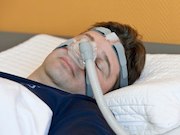Disturbed sleep linked to increased thickness in right postcentral gyrus, pericalcarine, pars opercularis
MONDAY, July 9, 2018 (HealthDay News) — Obstructive sleep apnea (OSA) is associated with changes to the structure of the brain that are seen in the early stages of dementia, according to a study published online July 5 in the European Respiratory Journal.
Nathan E. Cross, Ph.D., from the University of Sydney, and colleagues assessed associations between OSA and cortical thickness in 83 middle-aged and older adults (51 to 88 years) considered at risk for dementia. Participants underwent neuropsychological testing, polysomnography assessment of OSA, and a structural magnetic resonance imaging brain scan.
The researchers found that oxygen desaturation was significantly related to reduced cortical thickness in the bilateral temporal lobes. However, sleep disturbance was associated with increased thickness in the right postcentral gyrus, pericalcarine, and pars opercularis, as well as increased volume of the hippocampus and amygdala. Reduced verbal encoding was associated with decreased thickness in the bilateral temporal regions.
“Given the clinical significance of this sample in terms of dementia prevention, these changes in grey matter reveal how OSA might contribute to neurodegenerative processes in older adults,” the authors write.
Copyright © 2018 HealthDay. All rights reserved.








